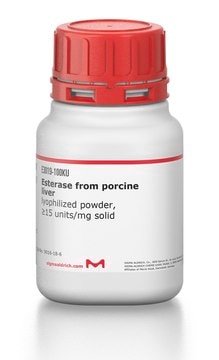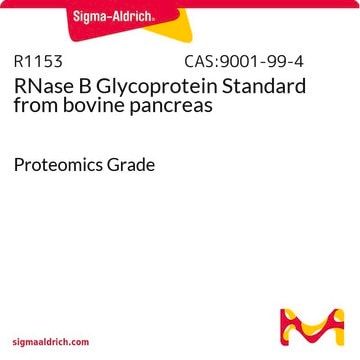The form of fetuin has not been determined. This material has not been sequenced. The minimum allowable sialic acid content is 0.5%. The molecular weight is approximately 44,200 daltons. The starting material for this product has a molecular weight of approximately 48,400 including an estimated 8.7% sialic acid. According to the UniPro values for each, the Fetuin-B molecular weight is calculated at 42,663 while the Fetuin-A is 38,419.
A4781
Asialofetuin from fetal calf serum
Type I (Sigma designation)
Synonym(s):
Asialofetuin
Select a Size
Select a Size
About This Item
Recommended Products
biological source
bovine (calf) serum
Quality Level
type
Type I (Sigma designation)
form
powder
impurities
salt, essentially free
≤0.5% N-acetylneuraminic acid
solubility
0.85% sodium chloride: soluble 1 mg/mL
storage temp.
2-8°C
Looking for similar products? Visit Product Comparison Guide
General description
Application
- to quantitate the plant Ricin toxin′s B subunit (RTB) lectin activity in β-phaseolin signal peptide (P)–proinsulin gene (INS)–RTB plants by enzyme-linked immunosorbent assay (ELISA)[2]
- quantitate VP7:RTB fusion protein in transformed potato tissues by ELISA[3]
- as a glycoprotein substrate to measure the receptor-binding activity of recombinant RTB and NSP490–RTB fusion proteins[4]
- to study the nature of the interaction between ferritin and the placenta[5]
Biochem/physiol Actions
Preparation Note
Storage Class Code
11 - Combustible Solids
WGK
WGK 3
Flash Point(F)
Not applicable
Flash Point(C)
Not applicable
Personal Protective Equipment
Choose from one of the most recent versions:
Certificates of Analysis (COA)
Don't see the Right Version?
If you require a particular version, you can look up a specific certificate by the Lot or Batch number.
Already Own This Product?
Find documentation for the products that you have recently purchased in the Document Library.
Customers Also Viewed
-
To wich fetuin corresponds your product A4781 (Asialofetuin from fetal calf serum). Is it Protein Fetuin-A ? Uniprot entry: P12763 FETUA_BOVIN or protein Fetuin-B ? Uniprot entry: Q58D62 FETUB_BOVIN Do you have de amino acid sequence?
1 answer-
Helpful?
-
-
Hi, What is the difference in Type 1 versus Type II asialofetuin
1 answer-
The difference between the Type I and Type II Asialofetuin products does not represent any kind of biochemical or functional difference. These indicate different methods of production and purification. The Type II option, product A1908, utilizes neuraminadase in an enzymatic cleavage step. The Type I, product A4781, uses a proprietary modification of that described in Spiro, R.G., J. Biol. Chem., 235, 2860 (1960).
Helpful?
-
Active Filters
Our team of scientists has experience in all areas of research including Life Science, Material Science, Chemical Synthesis, Chromatography, Analytical and many others.
Contact Technical Service
















